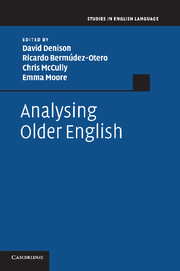Book contents
- Frontmatter
- Contents
- Figures and maps
- Tables
- Contributors
- General introduction
- Part I Metrics and onomastics in older English
- Part II Writing practices in older English
- Part III Dialects in older English
- Part IV Sound change in older English
- 12 Introduction to Part IV
- 13 Syllable weight and the weak-verb paradigms in Old English0
- 14 How to weaken one’s consonants, strengthen one’s vowels and remain English at the same time
- 15 Degemination in English, with special reference to the Middle English period
- Part V Syntax in older English
- References
- Index
14 - How to weaken one’s consonants, strengthen one’s vowels and remain English at the same time
Published online by Cambridge University Press: 05 December 2011
- Frontmatter
- Contents
- Figures and maps
- Tables
- Contributors
- General introduction
- Part I Metrics and onomastics in older English
- Part II Writing practices in older English
- Part III Dialects in older English
- Part IV Sound change in older English
- 12 Introduction to Part IV
- 13 Syllable weight and the weak-verb paradigms in Old English0
- 14 How to weaken one’s consonants, strengthen one’s vowels and remain English at the same time
- 15 Degemination in English, with special reference to the Middle English period
- Part V Syntax in older English
- References
- Index
Summary
Introduction
When one tries to make sense of the historical development of languages, one will at one point or other face puzzles like the following. On a purely descriptive level, it often appears that the development of a specific language follows clearly discernible trends over very long periods. For example, this paper will show that during the last millennium, English seems to have gradually and steadily reduced its inventory of consonants and consonant clusters by a series of weakening processes, while a similar development cannot be detected among vowels, which seem to have been strengthened quite frequently through processes like lengthening, peripheralisation and diphthongisation. Also, vocalisations of consonants have been frequent, while changes in the opposite direction do not seem to have occurred at all. In a way it seems as if English had preferred vowels over consonants for a very long period. Indeed, long-term trends such as this have caused linguists to observe as follows:
Languages . . . came into being, grew and developed according to definite laws, and now, in turn, age and die off . . .
(Schleicher 1873: 6)Language moves down time in a current of its own making. It has a drift.
(Sapir 1921: 151)A living language is not just a collection of autonomous parts, but, as Sapir (1921) stressed, a harmonious and self-contained whole, massively resistant to change from without, which evolves according to an enigmatic, but unmistakably real, inner plan.
(Donegan and Stampe 1983: 1)languages . . . are objects whose primary mode of existence is in time . . . which ought to be viewed as potentially having extended (trans-individual, transgenerational) ‘lives of their own’.
(Lass 1987: 156–7)At the same time – and as Donegan and Stampe’s choice of the term ‘enigmatic’ indicates – such trends are difficult to account for, because it is hard to see in what way languages should at all be able to exert any causal influence on their own development.
The basic problem is that there is no empirically meaningful way to think of a language as both being a ‘self-contained whole’ and ‘moving down time’ or ‘evolving to an inner plan’. Empirically interpretable instantiations of language exist in the form of (a) written or spoken texts, (b) speech acts (i.e. behavioural events) and (c) the knowledge systems that are implemented in the mind-brains of individual speakers. These instantiations can be construed as ‘wholes’, but they do not persist in time in a way that amounts to what is called the historical development of a language. Spoken texts disintegrate more or less instantly. Written texts decay more slowly and have some temporal persistence, but the fate of a text is clearly something completely different from the fate of a language. And the linguistic knowledge systems of individual speakers do maintain some stability throughout the adult lives of speakers, so they can be said to persist in time while undergoing some development, but the development of an individual speaker’s language competence is not the same as the evolution of a language in the historical sense, and anyway ends with his/her life. The only empirically interpretable way in which languages ‘move down time’, on the other hand, is through their transmission from older to younger speakers, and the problem is that they are never transmitted as self-contained ‘wholes’. Rather, individual speakers’ languages, that is, the knowledge they have and put to use, are ‘idiolects’ and represent specific and idiosyncratic mixtures of the constituents available in the speech community. This is well established by abundant evidence from variationist research, and implies that the languages which ‘move down time’ are populations of idiolects rather than objects or ‘wholes’. All historical developments which languages in this sense undergo are changes in the token frequencies of constituent variants that exist in a population. They are brought about by the selections which speakers make when they construct their specific idiolects from the constituent variants that are available in the community, or when they put specific constituents to use in communication. To the extent that tokens of constituent variants can be transmitted faithfully among speakers, it can be said that they do establish types, or ‘lineages’, and thereby persist in time. Languages do not. In short, when it comes to persistence in time, there seems to be no empirically meaningful way to construe languages as ‘wholes’.
- Type
- Chapter
- Information
- Analysing Older English , pp. 213 - 231Publisher: Cambridge University PressPrint publication year: 2011



